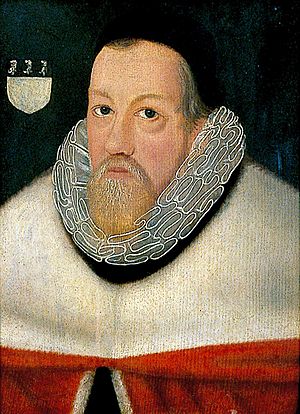Thomas Richardson (judge) facts for kids
Sir Thomas Richardson (1569 – 4 February 1635) was an important English judge and politician. He came from Honingham in Norfolk. He served in the House of Commons from 1621 to 1622. During this time, he was the Speaker of the House of Commons. Later, he became a top judge, serving as Chief Justice of the Common Pleas and then Chief Justice of the King's Bench.
Contents
Early Life and Education
Thomas Richardson was born in Hardwick, Norfolk, in 1569. He was baptised on July 3, 1569. His family was said to have come from a Norman family. However, some records suggest his family was from a farming background in Norfolk.
He went to Norwich School for his education. Later, in June 1584, he studied at Christ's College, Cambridge.
In 1587, he began studying law at Lincoln's Inn. He became a lawyer there in 1595. Around 1600, he bought a large property called Honingham in Norfolk. This became his main home.
He held several important legal jobs. He was a deputy steward for the church in Norwich. He also built Honingham Hall around this time. He later became a recorder for Bury St. Edmunds and then Norwich. A recorder is a judge who helps with legal matters in a town.
Speaker of Parliament
In 1621, Richardson was chosen to be a Member of Parliament for St Albans. When Parliament met, he was chosen as the Speaker of the House of Commons. The Speaker is like the leader of the debates in Parliament. They make sure rules are followed.
He seemed nervous about taking the job. Reports say he even "wept downright" when he accepted.
On March 25, 1621, he was made a knight by King James. This happened at Whitehall. During his time as Speaker, he was seen as a calm leader. He did not cause much trouble. He was not chosen to be a Member of Parliament in the next election.
Becoming a Judge
In 1625, Richardson became a King's Serjeant, which is a high legal position. In 1626, he became the Chief Justice of the Common Pleas. This was a very important judge role. It was said that this promotion cost him a lot of money.
In 1628, he made a key decision. He ruled that it was illegal to use torture, like the rack, to get a confession. This was for the case of Felton, who murdered the Duke of Buckingham. This decision was important for English law.
He also helped to limit the crime of treason. Treason is a serious crime against the king or country. His work helped make sure that only very serious acts were considered treason. He tried to be fair in his judgments. He was lenient with some people, like Richard Chambers. However, he agreed to harsh sentences for others, like Alexander Leighton and William Prynne.
Chief Justice of the King's Bench
In 1631, Richardson was promoted again. He became the Chief Justice of the King's Bench. This was the highest judge position. He worked on the western circuit, which meant he traveled to different courts.
He was not a Puritan, a strict religious group. In 1632, he tried to stop Sunday revels or parties in Somerset. These events often led to crime. He ordered that his decision be read in churches. This caused a problem with Archbishop Laud. Laud told him to cancel the order.
Richardson did not want to cancel it. He said the order was made by many judges. He also said similar orders had been made since the time of Queen Elizabeth. The king himself had to tell him to cancel it. Richardson felt pressured. He complained that he was "choked with the archbishop's lawn sleeves." This meant he felt controlled by the powerful archbishop.
Death
Sir Thomas Richardson passed away at his home in Chancery Lane on February 4, 1635. He was buried in Westminster Abbey. A marble monument marks his grave.
His Personality as a Judge
Richardson was a skilled lawyer. He was known for making jokes and witty remarks. When someone asked if a prisoner, William Prynne, should have books, Richardson joked, "Let him have the Book of Martyrs; for the puritans do account him a martyr."
He could even joke about himself. Once, a prisoner threw something at him. Richardson ducked and avoided it. He then said, "You see now, if I had been an upright judge I had been slain." This showed his sense of humor.
Family Life
Sir Thomas Richardson was married two times.
- His first wife was Ursula Southwell. She passed away in 1624. They had twelve children together, including:
- Sir Thomas Richardson (died 1645). He was meant to inherit a Scottish title, Lord Cramond, from his stepmother. But he died before her. His son, Thomas Richardson (1627–1674), later became the 2nd Lord Cramond.
- Mary Richardson (1600–1656/7). She married John Webb (1588–1658). Their special stone is still in Breckles Church in Norfolk.
- Elizabeth Richardson (1607–1655). She married Robert Wood.
- His second wife was Elizabeth Beaumont. They married in 1626. She was the widow of Sir John Ashburnham. They did not have any children together. In 1629, Elizabeth was given the title Lady Cramond in Scotland for her lifetime.
Images for kids







